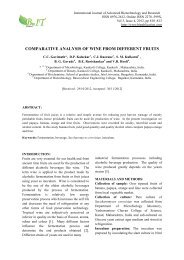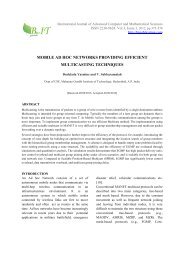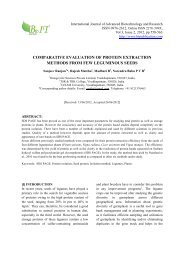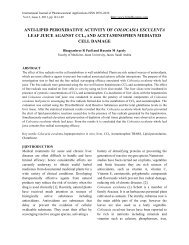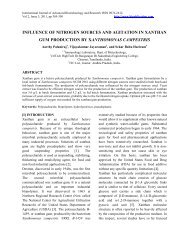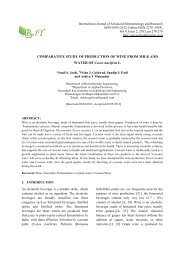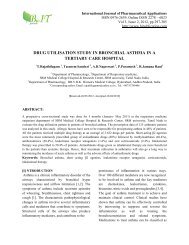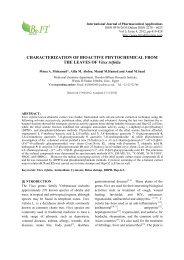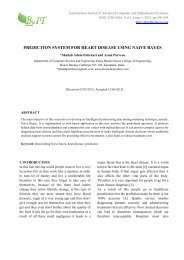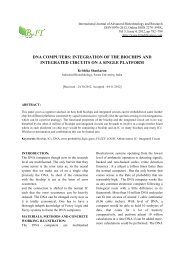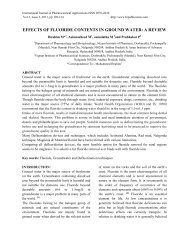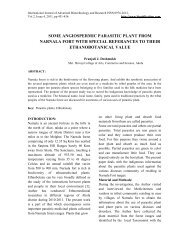ANTIBACTERIAL POTENTIALS OF Solanum indicum, Solanum ...
ANTIBACTERIAL POTENTIALS OF Solanum indicum, Solanum ...
ANTIBACTERIAL POTENTIALS OF Solanum indicum, Solanum ...
You also want an ePaper? Increase the reach of your titles
YUMPU automatically turns print PDFs into web optimized ePapers that Google loves.
International Journal of Pharmaceutical Applications<br />
ISSN 0976-2639.Online ISSN 2278 – 6023<br />
Vol 3, Issue 4, 2012, pp 414-418<br />
http://www.bipublication.com<br />
<strong>ANTIBACTERIAL</strong> <strong>POTENTIALS</strong> <strong>OF</strong> <strong>Solanum</strong> <strong>indicum</strong>, <strong>Solanum</strong><br />
xanthocarpum and Physalis minima.<br />
C.C. Gavimath * , S. M. Kulkarni 1 , C. J. Raorane 2 , D. P. Kalsekar 3 , B. G. Gavade 4 .<br />
B. E. Ravishankar 5 , R. S. Hooli 6 .<br />
* 1 2 3<br />
Department of Microbiology, Kankavli College, Kankavli, Maharashtra, India.<br />
4<br />
Department of Botany, Kankavli College, Kankavli, Maharashtra, India.<br />
5 Department of Biochemistry, School of graduate studies, Jain University, Bangalore, Karnataka, India.<br />
6<br />
Department of Medical surgical nursing, Nightingale Institute of Nursing, Noida, India.<br />
[Received-14/11/2012, Accepted-17/12/2012]<br />
ABSTRACT:<br />
In the present study, three plants belonging to family Solanaceae including <strong>Solanum</strong> <strong>indicum</strong>, <strong>Solanum</strong><br />
xanthocarpum and Physalis minima were evaluated for antimicrobial potentials against some selected pathogenic<br />
microorganisms. Five different solvents like ethanol, methanol, acetone, petroleum ether and aqueous were used for<br />
extraction of different bioactive constituents from fresh leaves by both hot and cold processes. The results suggested<br />
that different solvent extracts during study showed antibacterial potentials. The highest antibacterial activity was<br />
shown by methanolic and ethanolic extracts prepared by heat treatment of fresh leaves of Physalis minima, as<br />
compared to other solvents against all the selected strains. The fresh leaves of <strong>Solanum</strong> <strong>indicum</strong> showed moderate<br />
antibacterial activity when used with ethanol and methanol against Bacillus spp., Corynebacterium diptheriae,<br />
Streptococcus spp., Pseudomonas spp., and Salmonella typhimorium. While the plant extracts of <strong>Solanum</strong><br />
xanthocarpum showed least antibacterial activity.<br />
Keywords: Antibacterial, extract, solvent and well-diffusion<br />
INTRODUCTION:<br />
For a long period of time plants have been a<br />
valuable source of natural products for<br />
maintaining human health especially in the last<br />
decade with more intensive studies for natural<br />
therapies. In the last few years plants have been<br />
used as antimicrobial agents because of their<br />
antimicrobial traits. This property is due to the<br />
bioactive compounds synthesized during<br />
secondary metabolism in plants. According to<br />
World Health Organization medicinal plants<br />
would be the best source to obtain variety of<br />
drugs. About 80% of individuals from developed<br />
countries use traditional medicine which has<br />
bioactive compounds derived from medicinal<br />
plants hence such plants should be investigated for<br />
better understanding of their properties, safety,<br />
efficacy and efficiency. The use of plant extracts<br />
with known antimicrobial properties can be of<br />
great significance in therapeutic usage.
<strong>ANTIBACTERIAL</strong> <strong>POTENTIALS</strong> <strong>OF</strong> <strong>Solanum</strong> <strong>indicum</strong>, <strong>Solanum</strong> xanthocarpum and Physalis minima.<br />
Making antibacterial drug therapy effective, safe<br />
and affordable has been the focus of interest<br />
during recent years.<br />
There are several reports on antimicrobial activity<br />
of different herbal extracts. Considering the above<br />
aspects an attempt has been made to carry out the<br />
screening for preliminary antibacterial activity of<br />
different plants used in Indian folk medicine.<br />
The aim of the study was to screen the<br />
antibacterial potentials of crude extracts of<br />
different solvents of some of the plants belonging<br />
to solanaceae family. In the present study three<br />
plants belonging to family Solanaceae viz,<br />
<strong>Solanum</strong> <strong>indicum</strong>, <strong>Solanum</strong> xanthocarpum and<br />
Physalis minima were evaluated for their<br />
antibacterial potentials.<br />
The plant <strong>Solanum</strong> <strong>indicum</strong> is much branched<br />
perennial under shrub up to 1.8m height, found<br />
mostly throughout warmer parts of India, Africa<br />
and Asia up to an elevation of 1500m. It is Stiff,<br />
prickly herb; prickles stout, re-curved. The leaves<br />
are 7.5- 15cm long, 2.5-10cm broad, alternate,<br />
lobed, entire, spines present on petiole and midrib.<br />
<strong>Solanum</strong> xanthocarpum is a very spiny diffused<br />
herb with a height of up to 1.2m. The young<br />
branches are densely covered with minute starshaped<br />
hair, while the mature branches are zigzag,<br />
covered with yellow, sharp shining prickles and<br />
spread close to the ground.<br />
Physalis minima is a small, delicate, erect, annual,<br />
pubescent herb, 1.5m tall. The leaves are petiolate,<br />
ovate to cordate, pubescent, delicate, exstipulate,<br />
acuminate, having reticulate palmate venation and<br />
undulate margins, dorsal surface of the leaves is<br />
dark green and the ventral surface is light green in<br />
color.<br />
<strong>Solanum</strong> <strong>indicum</strong> Linn. are the major sources of<br />
phenolic compounds in the human diet. Soluble<br />
phenolic acids were extracted with methanol [1].<br />
Different solvent extracts of <strong>Solanum</strong> <strong>indicum</strong><br />
exhibits anti-hypersensitive activity [2]. <strong>Solanum</strong><br />
<strong>indicum</strong> has an anti-inflammatory, anticancer and<br />
wound-healing potentials [3]. It has been used in<br />
folk medicine for the treatment of inflammation,<br />
toothache, ascites, oedema and wound infection.<br />
[4] .<br />
<strong>Solanum</strong> xanthocarpum exhibits larvicidal<br />
property, it kills Anopheles spp, Aedes spp. &<br />
Culex spp. which are the important mosquito<br />
vectors prevalent in arid regions [5]. The<br />
methanolic extract of <strong>Solanum</strong> xanthocarpum<br />
showed significant antinociceptive activity in mice<br />
[6]. It exhibits antifungal property, It shows cidal<br />
effect on Aspergillus flavus, A.niger and<br />
A.fumigatus. [7]. Fruit extract of <strong>Solanum</strong><br />
xanthocarpum was evaluated for its toxicity<br />
against Alternaria brassicae, the causal agent of<br />
Alternaria blight of Indian mustard [8]. The anti<br />
diabetic potentials of aqueous extract of <strong>Solanum</strong><br />
xanthocarpum fruits was studied in normal and<br />
streptozotocin-induced hyperglycemic rats [9].<br />
The antimicrobial potentials of solaneaceae family<br />
members are due to presence of tannins as one of<br />
the bioactive compound [10].<br />
The crude methanol extract and chloroform<br />
fraction of the whole plant of Physalis minima was<br />
investigated for anti-inflammatory, analgesic and<br />
antipyretic activities in albino mice and Wistar rats<br />
of either sex at 200 and 400 mg/kg, respectively<br />
[11]. Physalis minima exhibited ianticancer<br />
potentials [12]. It has potent alpha glycosidase<br />
inhibitory activity and would be effective in<br />
suppression of elevation in blood glucose after<br />
oral administration of maltose to rats [13].<br />
MATERIALS AND METHODS:<br />
Plant materials used:<br />
Leaves of <strong>Solanum</strong> <strong>indicum</strong>, <strong>Solanum</strong><br />
xanthocarpum and Physalis minima were used for<br />
the preparation of crude extracts for antibacterial<br />
studies.<br />
Microorganisms selected:<br />
The activity of the plant crude extract was studied<br />
for a broad range of microorganisms. i.e. Gram’s<br />
positive including Corynebacterium diphtheriae,<br />
Staphylococcus aureus, Streptococcus spp. and<br />
Bacillus spp. as well as Gram’s negative<br />
microrganisms including Escherichia coli.<br />
C.C. Gavimath, et al. 415
<strong>ANTIBACTERIAL</strong> <strong>POTENTIALS</strong> <strong>OF</strong> <strong>Solanum</strong> <strong>indicum</strong>, <strong>Solanum</strong> xanthocarpum and Physalis minima.<br />
Klebsiella pneumoniae. Pseudomonas spp. and<br />
Salmonella typhimorium.<br />
Maintenance of Microorganisms:<br />
The microorganisms were maintained on sterile<br />
nutrient agar slants in refrigerator and used as<br />
stock culture when it was required for performing<br />
this study.<br />
Preparation of culture suspension:<br />
Fresh culture was obtained by sub-culturing the<br />
microorganisms from stock culture on nutrient<br />
agar slants & incubated for 24 hours at 37 0 C. After<br />
24 hours, a loop full of the culture was added in<br />
3ml of sterile saline to prepare culture suspension.<br />
Preparation of Plant extracts:<br />
Fresh leaves were collected from the plant just<br />
before one day of antibacterial assay. The leaves<br />
were washed with water, air dried, powdered and<br />
then soaked overnight in appropriate amount of<br />
respective solvent. (10gms of leaves in 20ml of<br />
solvent.) On the next day, the soaked leaves were<br />
boiled with the same solvent in water bath for 30<br />
minutes to make it concentrated. The extract was<br />
cooled and filtered through muslin cloth.<br />
Method of bioassay:<br />
Activity of the prepared plant extract was tested<br />
using agar well diffusion method. The<br />
antimicrobial assay was carried out by making 3<br />
wells of 7mm diameter in the sterile nutrient agar<br />
plate containing test organism with the help of<br />
sterile cork borer. 0.1ml of plant extract was added<br />
in 2 wells and in the third well only a drop of<br />
solvent<br />
was added as control by using sterile pipettes. The<br />
plates were incubated at 37 0 C for 24 hours in an<br />
incubator to allow diffusion of extract in the<br />
medium. After 24 hours zone of inhibition of<br />
organisms was measured in millimeters.<br />
RESULTS & DISCUSSION:<br />
1) <strong>Solanum</strong> <strong>indicum</strong>:<br />
Among Gram’s positive organisms, the maximum<br />
zone of inhibition was exhibited by ethanol and<br />
aqueous extracts prepared by heat and cold<br />
treatment on Corynebacterium diphtheriae.<br />
Among Gram’s negative organisms, the maximum<br />
zone of inhibition was exhibited by petroleum<br />
ether extracts prepared by heat and cold treatment<br />
on Klebsiella pneumoniae, methanolic extract<br />
prepared by heat and cold treatment on<br />
Pseudomonas spp.and heat treated methanolic<br />
extract on Salmonella typhimorium<br />
<strong>Solanum</strong> xanthocarpum:<br />
Among Gram’s positive organisms, the maximum<br />
zone of inhibition was exhibited by ethanol<br />
extracts prepared by heat treatment on<br />
Corynebacterium diphtheriae. Among Gram’s<br />
negative organisms, the maximum zone of<br />
inhibition was exhibited by methanolic extracts<br />
prepared by cold treatment on Escherichia coli<br />
and Pesudomonas spp. and methanolic extract<br />
prepared by heat treatment on Klebsiella<br />
pneumoniae. Treatment on Escherichia coli and<br />
Salmonella typhimorium. The ethanolic extract<br />
prepared by heat treatment on Pesudomonas<br />
spp.and petroleum ether extract prepared by heat<br />
treatment on Pseudomonas spp.<br />
Physalis minima-<br />
Among Gram’s positive organisms, the maximum<br />
zone of inhibition was exhibited by methanol<br />
extracts prepared by heat treatment on<br />
Streptococcus spp.<br />
Among Gram’s negative organisms, the maximum<br />
zone of inhibition was exhibited by methanolic<br />
extracts prepared by heat.<br />
The present study was conducted to get<br />
preliminary information on the antibacterial<br />
activity of methanol, ethanol, petroleum ether,<br />
acetone and aqueous extracts of <strong>Solanum</strong> <strong>indicum</strong>,<br />
<strong>Solanum</strong> xanthocarpum and Physalis minima<br />
leaves and for this the well diffusion method was<br />
adopted.<br />
The results suggest that different solvent extracts<br />
used for the study showed antibacterial activity.<br />
The extract from fresh leaves prepared in<br />
methanol and ethanol has greater antibacterial<br />
activity than in acetone, petroleum ether and<br />
aqueous.<br />
C.C. Gavimath, et al. 416
<strong>ANTIBACTERIAL</strong> <strong>POTENTIALS</strong> <strong>OF</strong> <strong>Solanum</strong> <strong>indicum</strong>, <strong>Solanum</strong> xanthocarpum and Physalis minima.<br />
The extracts prepared by heat treatment were<br />
remarkably effective than cold treatment extracts<br />
against all the selected microorganisms. The result<br />
of the present study revealed that Physalis minima<br />
leaves extract had broad spectrum antibacterial<br />
effects producing zone of inhibition more than<br />
20mm. <strong>Solanum</strong> <strong>indicum</strong> and <strong>Solanum</strong><br />
xanthocarpum on the other hand does not appear<br />
to possess appreciable antimicrobial effects on<br />
Gram’s positive and Gram’s negative bacteria.<br />
The anti-bacterial action of various extracts of<br />
<strong>Solanum</strong> <strong>indicum</strong>, <strong>Solanum</strong> xanthocarpum and<br />
Physalis minima leaves indicated their potentials<br />
as antibacterial herbal remedies due to the<br />
cumulative effect of all the bioactive compounds<br />
present in the plants.Further work is needed to<br />
locate the active principle from the various<br />
extracts and their phytochemical studies.<br />
REFERENCES:<br />
1) Aberoumandl A., & Deokule S., (2008),<br />
“Comparison of Phenolic Compounds of Some<br />
Edible Plants of Iran and India”.Pakistan Journal<br />
of Nutrition, 7 (4), 582-85.<br />
2) Bahgat A., Abdel A., Raafat M., Mahdy A., ELkhatib<br />
A., Ismail A., & Khayyal M., (2008),<br />
“<strong>Solanum</strong> <strong>indicum</strong> ssp. distichum extract is<br />
effective against L-NAME induced hypertension<br />
in rats”. Fundamental & clinical<br />
pharmacology, 22 (6), 693-99.<br />
3) Ma P., Cao T.T., Gu G.F., Zhao X., Du Y.G., &<br />
Zhang Y., (2006), “Inducement effect of synthetic<br />
indiosides from <strong>Solanum</strong> <strong>indicum</strong> L. on apoptosis<br />
of human hepatocarcinoma cell line Bel-7402 and<br />
its mechanism”. Chinese journal of Cancer, 25(4),<br />
438-42.<br />
4) Huang W.H. Hsu C.W.,& Fang J.T., (2008):<br />
Central diabetes insipidus following digestion<br />
<strong>Solanum</strong> <strong>indicum</strong> L. concentrated<br />
solution .Clinical Toxicology, 46(4), 293 –96<br />
5) Bansal S., Singh K., & Kumar S., (2009), “<br />
Larvicidal activity of the extracts from different<br />
parts of the plant <strong>Solanum</strong> xanthocarpum against<br />
important mosquito vectors in the arid region”.<br />
Journal of Environmental Biology, 2, 221-26.<br />
6) Rahman M., Ahmed M., Alimuzzaman M., &<br />
Shilpi J., (2003), “Antinociceptive activity of the<br />
aerial parts of <strong>Solanum</strong> xanthocarpum”.<br />
Fitoterapia, 74 (1-2),119-12.<br />
7) Dabur R., Singh H., Chhillar A., Aliand M., &<br />
Sharma G., (2004), “Antifungal potential of<br />
Indian medicinal plants”. Fitoterapia, 75(3-4),<br />
389-91.<br />
8) Guleria S., Kumar A., & Tiku A., (2010),<br />
“Toxicity of <strong>Solanum</strong> xanthocarpum fruit extract<br />
against Alternaria brassicae, causal agent of<br />
Alternaria blight of Indian mustard (Brassica<br />
juncea)”. Archives Of Phytopathology And Plant<br />
Protection, 43(3) , 283-89.<br />
9) Gupta S., Mal M., & Bhattacharya P., (2005),<br />
“Evaluation of hypoglycemic potential of<br />
<strong>Solanum</strong> xanthocarpum (Solanaceae) fruits in<br />
Normal and Streptozotocin induced Diabetic<br />
Rats”. European Bulletin of Drug Research, 13<br />
10) Doss A., Mubarack H., & Dhanabalan R., (2009),<br />
“Antibacterial activity of tannins from the leaves<br />
of <strong>Solanum</strong> trilobatum Linn”. Indian Journal of<br />
Science and Technology, 2(2).<br />
11) Khan M., Khan H., Khan S., Mahmood T., Khan<br />
P.M., & Jabar A., (2009), “Anti-inflammatory,<br />
analgesic and antipyretic activities of Physalis<br />
minima Linn”. Journal of Enzyme Inhibition and<br />
Medicinal Chemistry, 24( 3) ,632 -37.<br />
12) Ooi K., Sifzizul T., Muhammad T., & Sulaiman<br />
T., (2009), “ Cytotoxic Activities of Physalis<br />
minima L. Chloroform Extract on Human Lung<br />
Adenocarcinoma NCI-H23 Cell Lines by<br />
Induction of Apoptosis”. Evidence-based<br />
Complementary and Alternative Medicine, 585-<br />
90.<br />
13) Sathis Kumar D., Raju S., Harani A., Banji D.,<br />
Rao K., & Banji O., (2009) “Alpha-Glucosidase<br />
Inhibitory and Hypoglycemic Activities of<br />
Physalis minima Extract”. Pharmacognosy<br />
Journal , 1 (4),273-78.<br />
C.C. Gavimath, et al. 417
<strong>ANTIBACTERIAL</strong> <strong>POTENTIALS</strong> <strong>OF</strong> <strong>Solanum</strong> <strong>indicum</strong>, <strong>Solanum</strong> xanthocarpum and Physalis minima.<br />
Solvent<br />
Organisms<br />
Methanol<br />
Ethanol<br />
Petroleum<br />
ether<br />
Acetone<br />
Aqueous<br />
HT CT HT CT HT CT HT CT HT CT<br />
BC 15.5 13.5 14.5 12.0 - - - - - -<br />
Table 1: The antimicrobial activity of<br />
fresh leaves extract of <strong>Solanum</strong> <strong>indicum</strong><br />
against selected microorganisms.<br />
CD 10.0 12.0 22.5 21.5 14.5 13.0 19.5 15.5 25.5 22.5<br />
SA 10.5 9.5 - - 14.0 15 - - - -<br />
SC 15.0 14.0 16.0 13.0 15.0 14.0 13.0 9.5 - -<br />
EC - - 10.5 12.0 13.0 12.0 - - - -<br />
KP - - - - 17.0 16.0 12.0 10.0 - -<br />
PM 16.0 16.5 12.5 14.0 9.5 9.5 - - - -<br />
ST 17.0 15.5 9.0 9.5 11.0 10.0 - - - -<br />
Note:BC-Bacillus spp., CD-<br />
Corynebacterium diptheriae, SA-<br />
Staphylococcus aureus, SC-Streptococcus<br />
spp., EC-Escherichia coli, KP-Klebsiella<br />
pneumoniae, PM- Pesudomonas spp., ST-<br />
Salmonella typhimorium, HT- heat treatment,<br />
CT-cold treatment, mm-millimeters<br />
Solvents<br />
Organisms<br />
Methanol Ethanol Petroleum<br />
ether<br />
Acetone<br />
Aqueous<br />
HT CT HT CT HT CT HT CT HT CT<br />
BC 9.5 9.0 8.5 9.5 8.0 8.0 9.5 9.5 - -<br />
CD 8.5 9.5 14.0 12.0 9.0 12.0 11.5 11.0 - -<br />
SA 10.0 9.5 11.0 10.0 11.0 10.0 12.0 11.0 - -<br />
SC 9.5 8.5 8.0 8.5 12.0 8.5 9.0 9.0 - -<br />
EC 12.0 13.0 9.5 9.0 9.5 9.0 8.5 9.0 - -<br />
KP 13.0 11.0 12.5 11.0 12.5 11.0 11.0 10.0 - -<br />
PM 12.0 13.0 11.5 11.0 11.5 11.0 9.5 10.0 - -<br />
ST 10.0 9.5 9.5 9.0 9.5 10.0 11.0 11.0 - -<br />
Table 2: The antimicrobial activity of<br />
fresh leaves extract of <strong>Solanum</strong><br />
xanthocarpum against selected<br />
microorganisms<br />
Solve<br />
nts<br />
Orga<br />
nisms<br />
Methanol Ethanol Petroleum<br />
ether<br />
Acetone<br />
Aqueous<br />
HT CT HT CT HT CT HT CT HT CT<br />
BC 22.5 19.0 23.5 21.5 13.5 16.0 15.0 22.5 14.5 14.5<br />
CD 20.5 18.0 23.5 17.0 14.0 12.5 21.5 20.5 17.0 18.0<br />
SA 12.5 15.0 17.5 12.0 17.5 15.0 15.5 14.5 14.5 12.5<br />
Table 3: The antimicrobial activity of<br />
fresh leaves extract (hot treatment) of<br />
Physalis minima against selected<br />
microorganisms<br />
SC 27.5 20.0 20.0 14.0 20.0 12.5 17.5 21.0 17.5 18.0<br />
EC 27.5 20.0 22.5 21.0 22.5 16.5 16.5 24.0 24.0 19.0<br />
KP 22.0 21.0 24.5 20.0 24.5 24.0 13.5 21.0 20.0 16.5<br />
PM 20.0 20.0 27.0 24.0 27.0 20.0 10.5 24.0 16.5 13.0<br />
ST 27.5 15.5 16.0 12.0 16.0 13.0 15.0 14.5 22.5 16.0<br />
C.C. Gavimath, et al. 418



